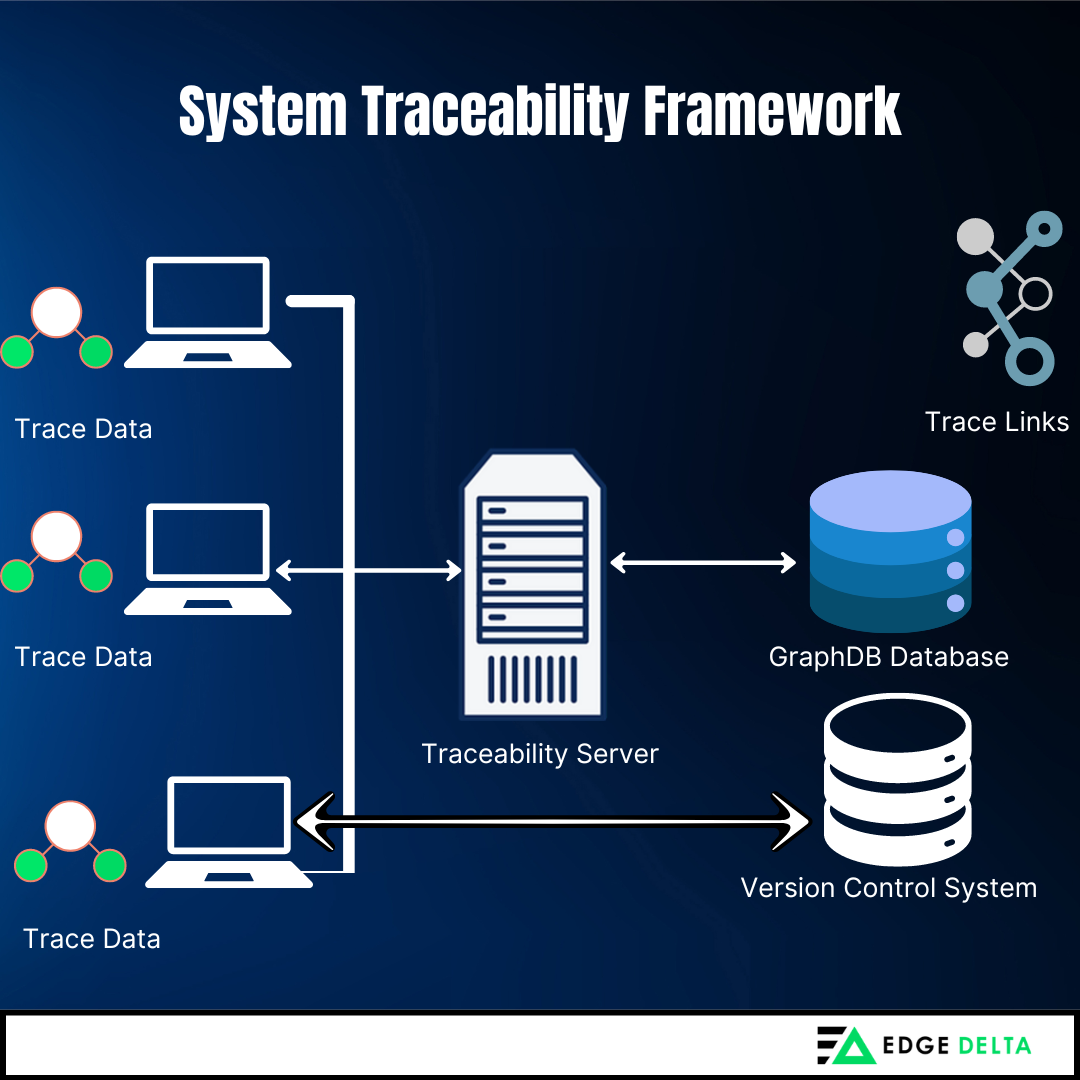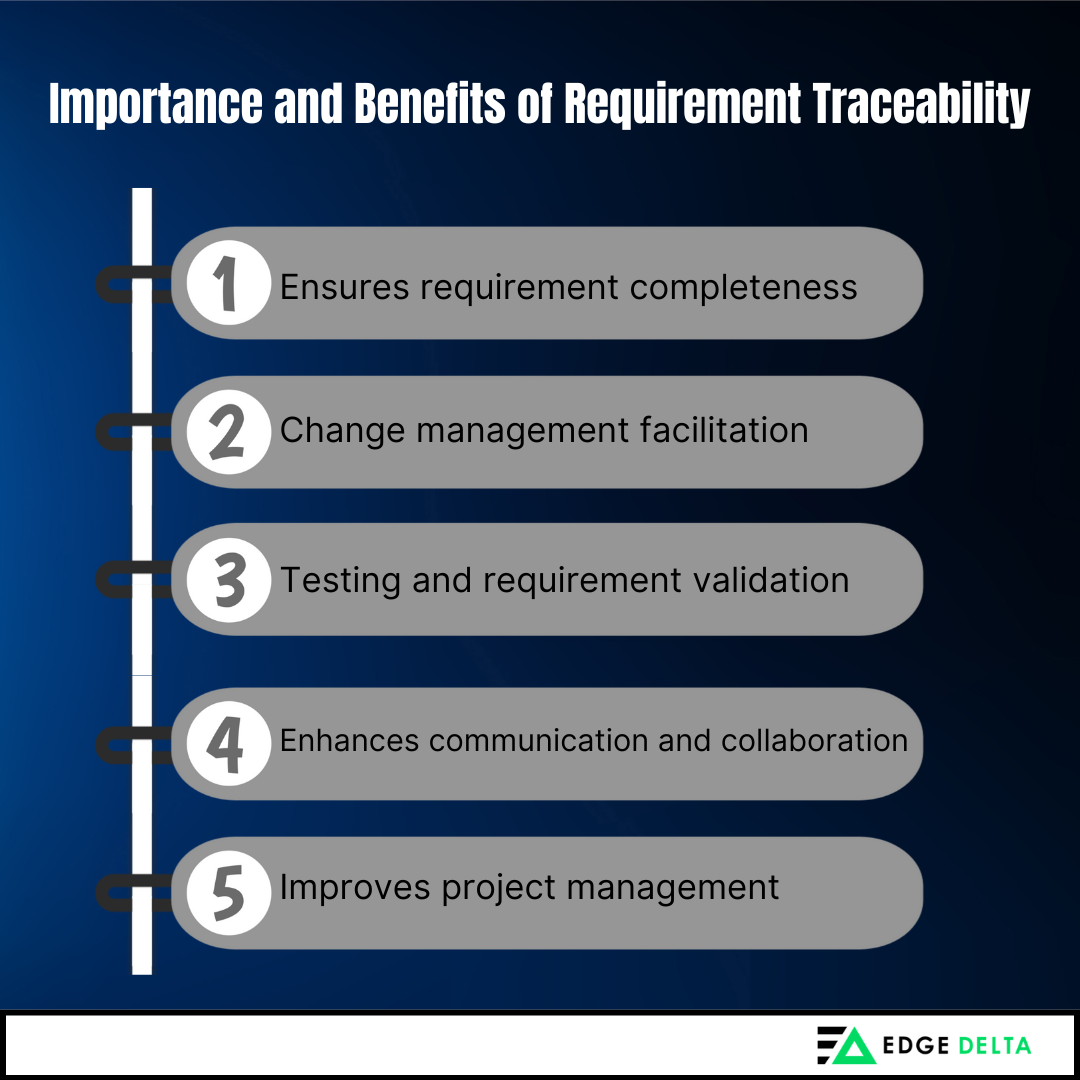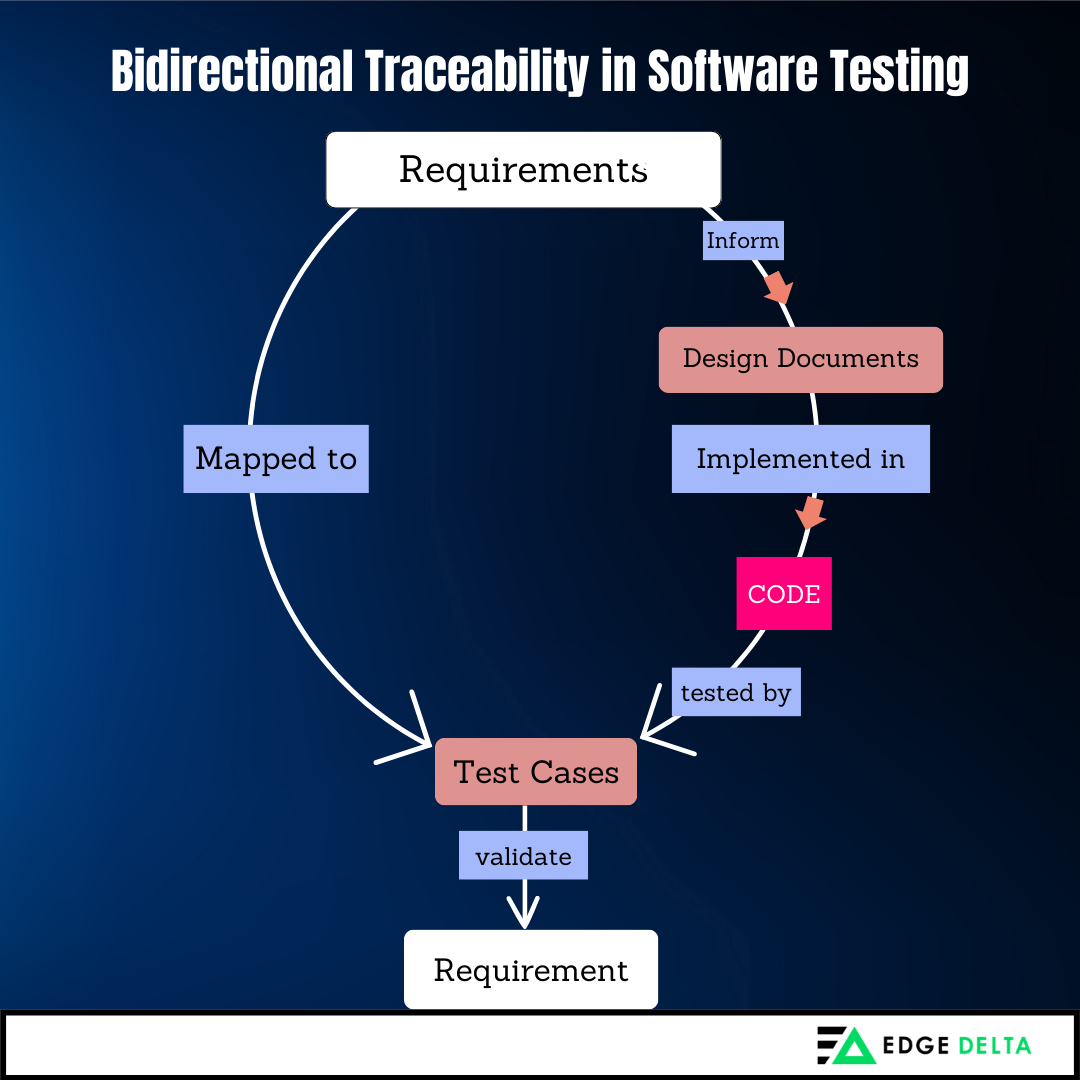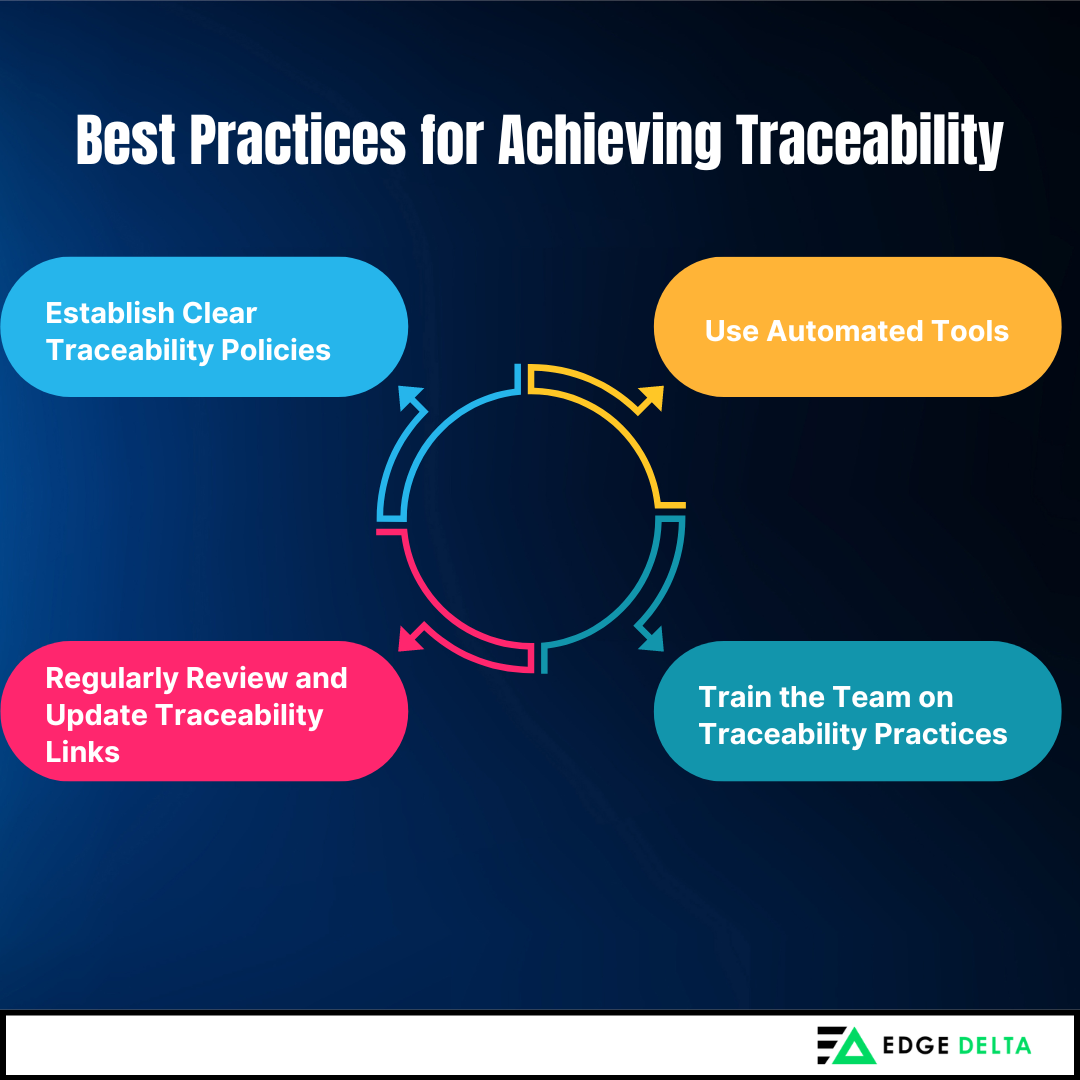System traceability plays a critical role in system maintenance and evolution. It provides business context at every stage of the software development life cycle, delivering insights into why the application is designed the way it is and providing a mechanism to create test cases targeting specific software functionality.
In software engineering, traceability describes the extent to which documentation or code can be traced back to its point of origin. It aims to provide better quality and consistency in product development, and using documented identification, it allows for the verification of the following
- Item’s history
- Location
- Application
In this article, discover all you need to know about system traceability- what it is, how to implement it, and more.
Key Takeaways
- Traceability works by associating two or more trace links to work items in application development and system.
- In software engineering, system traceability is used to ensure requirement coverage and help with testing and validation.
- Requirement traceability is a systematic process that acts as a compass, ensuring that every design choice and coding effort follows the original requirements.
- Achieving traceability is challenging and requires a strategic approach, which includes establishing clear traceability policies and using automated tools.
- Familiarization with traceability techniques and practices is crucial in attaining influential associations.
How Does System Traceability Work?
Establishing traceability links between various elements of the software development lifecycle requires extensive work and an intricate process.
Traceability works by associating two or more trace links to work items in application development and system. This link implies a dependency between the items. Requirements and test cases are often traced. Some companies leverage requirement tools and standard spreadsheets as tracing matrices, while others opt for third-party solutions to ensure system success.

The relationships between all elements in the engineering process are formally recorded to gain successful traceability. This way, engineers can identify a change in one element’s influence on the project. This impact analysis immediately identifies which part of the system needs to be changed to adapt to a requested or mandated change. This includes:
- Other architectures
- Design
- Tests
- Software
Discover more about system traceability in software engineering in the following section.
System Traceability in Software Engineering
In software engineering, system traceability is used to keep track of what’s going on in the development lifecycle and show what’s happened. It helps mitigate biosecurity risks and enables prompt responses to any issues. Additionally, traceability offers the following benefits.
- Ensuring Requirement Coverage: Traceability helps with testing and validation by allowing users and developers to track each requirement from its initial conception to implementation. This ensures the system is thoroughly tested and all requirements have been met.
- Facilitating Impact Analysis: This approach traces connections across a project or system, showing how changes in one area can affect others for a comprehensive understanding. It’s beneficial for complex projects with interconnected elements.
- Enhancing Project Transparency: Transparency and traceability are pivotal in ensuring organizations can implement governance practices, mitigate risks, strengthen operational efficiencies, and establish credibility with stakeholders and consumers.
- Aiding in Compliance and Audits: Traceability facilitates compliance with industry standards and legal regulations, making audits smoother and more reliable.
Read on and learn what requirement traceability is, its types, and its importance in the following sections.
What Is Requirement Traceability?
Requirement traceability is defining and following a requirement’s forward and backward trace in the development cycle. The requirements are traced through development and specification, subsequent deployment and use, and all ongoing refinement and iteration periods in any of these phases.
- Forward traceability: The ability to trace a requirement to components of a design or implementation.
- Backward traceability: The ability to trace a requirement to its source, such as a person, institution, law, or argument.

The purpose of requirements traceability is to define, capture, follow the traces left, and verify that requirements are met on other elements of the software development environment – accelerating an application’s development cycle.
Software engineers and developers need requirement tracing to track testing and ensure their product meets all customer requirements. It is beneficial for large, complicated projects for the following purposes:
- Record work
- Coordinate with a team
- Shows fulfilled legal requirements
In the following section, you’ll learn how requirement traceability works and its importance and benefits.
Importance and Benefits of Requirement Traceability
Requirements traceability is critical to the requirements management process. Traceability helps guarantee that the requirements are administered as intended and that changes are tracked and managed. Additionally, requirement traceability offers several benefits, which include the following:
- Ensures requirement completeness: Requirements are captured and documented, ensuring no gaps, missing information, and a poorly designed system.
- Change management facilitation: Manages changes by tracking the impact on the requirements and ensuring that these affected requirements are updated, meeting the stakeholder’s needs.
- Testing and requirement validation: Traceability ensures all requirements are valid, well-defined, and aligned with stakeholders’ expectations.
- Enhances communication and collaboration: Provides a clear understanding of the requirements and dependencies and ensures everyone has the same goal. It also allows stakeholders to see the bigger picture and understand the overall project.
- Improves project management: It provides transparency and visibility in the project’s progress, allowing managers to verify the status of each requirement, recognize any issues, and take corrective measures on problems promptly.

Requirements Traceability Implementation Techniques
In software development, requirement traceability is a systematic process acting as a compass, ensuring that every design choice, every coding effort, and every phase of testing stays in line with the original requirements. Requirements traceability can be achieved through various techniques and supported by specialized tools.
Some standard methods include:
- Automated Traceability Tools. Dedicated traceability tools and software automate the linking process, improving efficiency and minimizing errors.
- Manual Traceability Matrix. This process ensures that a matrix is created that manually links each requirement to relevant design, code, and test artifacts. While effective for smaller projects, this approach could be time-consuming.
- Version Control Systems. Integrated version control systems like Git may also help with requirements traceability by tracking changes to code files and tying them back to relevant requirements.
Now that you have learned what requirement traceability is read on and learn important concepts about traceability in software testing.
What is Traceability in Software Testing?
Traceability in software testing provides the ability to test and examine forward and background traces throughout the development cycle. It generally involves linking test cases and results to the corresponding requirements and design specifications.
Test cases are traced forward for test runs, and then traced runs are traced forward for specific issues that need fixing or when it has passed the test. Further, test cases and test runs can be traced backward to requirements; some developers use a matrix.
A traceability matrix is employed in software testing- a document that illustrates the relationship between requirements and other artifacts. Such a matrix includes the following:
- Requirements, user stories, or epics
- Test cases for those requirements/user stories/epics
- Test runs and their results
- Issues or defects and whether they’ve been resolved
Parameters to be Included in Traceability Matrix
The requirement traceability matrix is commonly created according to specific requirements, standards, and parameters. This ensures that all test cases are covered and no functionality is missed during testing. Below are a few of the parameters:
- Requirement ID
- Type
- Description
- Test execution status
- Risks if any
- Defects and status
- System tests
- User Acceptance Test (UAT) Status
- Unit tests
- Integration tests
- Test Case ID
- Test case design
Learn the different types of software traceability matrix in the following section.
Types of Software Testing Traceability Matrix
A traceability matrix—otherwise known as a test matrix—proves that tests have been run in software testing. Different types of traceability matrixes exist, each serving different purposes. Below are the common types of software testing traceability matrixes.
- Forward Traceability: This type focuses on mapping requirements to test cases, ensuring completeness in testing efforts by confirming test cases with specific functionalities.
- Backward Traceability: Involves tracing test cases back to the originating requirements. It ensures that every test case has a clear association with one or more standards. It also validates each test case’s Traceability and identifies redundant or obsolete ones.
- Bidirectional Traceability: This approach combines forward and Traceability, establishing a two-traceability between requirements and test cases. Furthermore, it ensures that each requirement has corresponding test cases linked to the originating requirements.

- Vertical Traceability: Extends beyond requirements and test cases to encompass other artifacts throughout the software development lifecycle, such as design documents, code modules, and user manuals. It enables stakeholders to trace the evolution of various elements across different phases of development, ensuring consistency and coherence in the final product.
- Horizontal Traceability: Focuses on establishing traceability relationships between artifacts within the same development phase. This type of Traceability improves collaboration among testing teams, ensuring that efforts are synchronized and aligned toward common goals.
There are different practices for achieving traceability. Read the following section to learn the details.
Best Practices for Achieving Traceability
Traceability enables teams to analyze and manage risks effectively. Determining connections between specifications, test cases, and shortcomings allows teams to prioritize testing efforts, distribute funds efficiently, and tackle zones of most significant risk at the beginning of the development lifecycle.
Achieving traceability is challenging and requires a strategic approach. Here are some of the best practices for achieving traceability:
- Establish Clear Traceability Policies
- Use Automated Tools
- Regularly Review and Update Traceability Links
- Train the Team on Traceability Practices

In the following section, let’s break down all of these practices;
Establish Clear Traceability Policies
Establishing a clear policy is a best practice for traceability; this will serve as a guide and standard for users and developers and minimize the chances of encountering system issues and problems.
Use Automated Tools
Dedicated traceability tools and software automate the linking process, improving efficiency and minimizing mistakes. Additionally, automated tools maintain traceability links and manage traceability data. These tools include:
- Visure Requirements
- Modern Requirements4DevOp
- ReQtest
Regularly Review and Update Traceability Links
The requirement for traceability changes every time and has to contain necessary and current information for the order to be functional. As the testing components progress or add or remove requirements, an updated traceable can show progress and what developers and users have left to do.
Train the Team on Traceability Practices
Familiarization with traceability techniques and practices is crucial in attaining influential associations between various items. Training the team is very critical to the success of the system operation.
If the development team is familiar with all of these practices and by tracing code back to design and requirements, the team can have significant results and attain the following
- Decrease errors
- Improve communication
- Produce software that meets user expectations
Conclusion
Modern cloud services and log management solutions have become rampant in today’s digital landscape. Tracing has become embedded with logs, allowing developers and other users to gain insight into the system’s developmental lifecycle and troubleshooting opportunities.
System traceability is an effective way for development and DevOps teams to understand the root of issues and how to fix them efficiently, ultimately making the system run efficiently. Additionally, it allows users to reclaim flexibility and visibility and monitor with confidence.
FAQ on System Traceability
What is traceability, and how can it be implemented?
Traceability traces all processes from gathering raw materials to production, consumption, and disposal, clarifying when and where the product was produced and by whom.
What is system traceability?
System traceability involves many factors, including the requirement identifier, test case identifier, requirement summary text, and test case status.
What should be considered when establishing and implementing the traceability system?
System traceability involves many factors, including the requirement identifier, test case identifier, requirement summary text, and test case status.
How to implement traceability in manufacturing?
In the manufacturing industry, traceability includes Barcode scanning inventory management systems, RFID inventory management software, and other unique identification methods.






